
There can’t be much doubt that the mobile web is exploding in popularity. From the first mobile web access offered commercially with the Nokia 9000 Communicator phone in Finland in 1996, things have moved fast.
Today we’re seeing increased sales in smartphones and tablets, faster mobile data connections, apps, and more. Basically, we’re accessing Internet services more and more from something that is not a PC.
We’ve put together some numbers to attempt to show a picture of what the mobile web was like so far in 2011, how it is has developed, and perhaps take a peek into the future as well.
From trim and slim to media galore
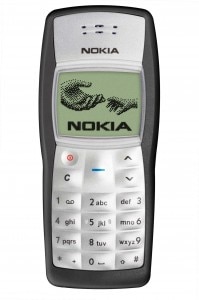
The mobile web used to mean trimmed-down web pages, accessed over WAP or other slow connections, serving up mainly text-based content to mobile phones with small screens.
Displays were measured in hundreds of pixels or less and the main method of input was the good old numerical keypad present on most mobile phones.
Today we see smartphones growing bigger and faster, now even with HD displays and soon with quad-core processors. With 4G connections reaching into speeds of hundreds of megabits per second, even a feature-length movie can be downloaded in minutes or streamed live.
Add tablets to that mix, which are often powered by even more powerful processors and have displays of up to 10-inches, making them suitable for browsing regular web pages in their full glory.
By adopting these latest mobile devices, users’ expectations have changed dramatically. Today mobile web users expect a site to load just as fast on their mobile device as it does on their desktop.
That means more work for you if you design and develop websites. But it also means tremendous opportunities for your business.
More and more smartphones
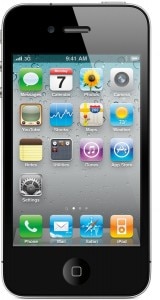
Although a smartphone is not required to access the mobile web it sure helps having the larger display with touch input, faster processor, and more storage that a mobile phone usually offers.
And customers worldwide are picking up smartphones almost faster than manufacturers can make them, it seems.
- 5.9 billion – The estimated number of mobile subscriptions worldwide in 2011.
- 13% – The smartphone share of all mobile handsets in use worldwide.
- 78% – The percentage of worldwide mobile data traffic that is consumed by smartphones.
- 1.6 billion – Number of mobile devices sold to end users in 2010, an increase of almost 32% compared to the year before.
- 19% – The percentage of worldwide mobile devices sold that were smartphones.
- 472 million – Number of smartphones estimated to be sold worldwide in 2011.
- 982 million – Estimated number of smartphones to be sold in 2015.
- 80% – The share of devices accessing mobile websites that have a touchscreen.
- 50 million – The number of people worldwide who have a mobile phone but that do not have electricity at home. In other words, mobile access has further reach than electricity.
Mobile data
Many smartphones and other mobile devices have support for Wi-Fi, but to be truly mobile they require some type of mobile data connection, such as 2G, 3G or 4G.
With faster connections come higher demand for mobile data. Although that demand has gone up significantly in recent years, the expectation is that it will continue to rise for a long time to come:
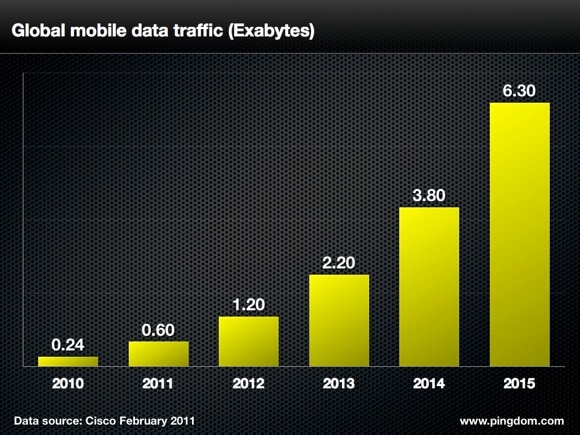
It’s hard to find any data numbers specific to mobile web, but here are a few that we find interesting:
- 21.1% – By 2015, Nokia Siemens projects that mobile users will use this much of their mobile data on “mobile web/other data”.
- 400 PB (petabyte) – The amount of mobile data traffic per month in the second quarter of 2011.
- 20% – The amount of mobile data traffic generated by the top 1% of mobile data subscribers.
- 1.2 billion – The number of active mobile broadband subscriptions worldwide in 2011.
Mobile web browsing
Web browsing is one of the most common activities on smartphones and tablets, with many devices being capable of displaying the full, rich experience of a regular website. But the web browsing experience doesn’t just depend on what hardware you have, it also depends to a large extent on what mobile web browser you use.
In the latest StatCounter figures, Opera is still the leading mobile web browser with 22.5% market share, followed by Mobile Safari on iOS with just over 24%. That’s when we combine iPhone and iPod touch in the iOS number. iPhone on its own is just under 20%.
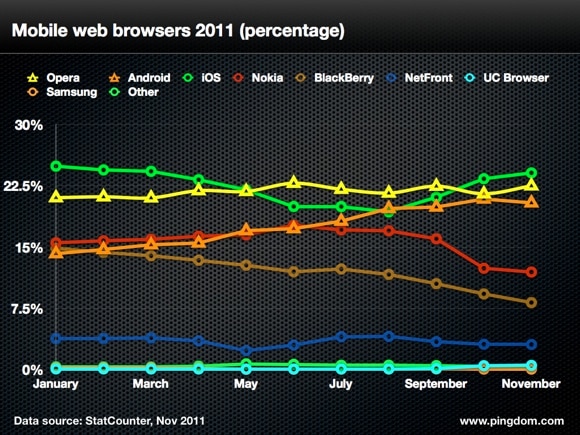
Other information we’ve found related to mobile web browsing:
- 85% – Percentage of handsets shipped globally in 2011 that will include some form of web browser.
- 60 – The number of different types and versions of mobile web browsers in use on mobile handsets.
- 6,500 – Estimate of the number of distinct web-capable mobile device models out there.
- 3 – Position of web browsing, behind messaging and apps, in a comparison of share of active smartphone usage.
- 11.7% – Percentage of web users in China that exclusively use a mobile device to access the web.
- 140 million – Number of people that used the Opera Mini browser in October 2011.
- 86.2 billion – Number of pages served By Opera Mini.
- 12.7 petabytes – Amount of operator data that was compressed for Opera Mini users.
- 6.95% – Mobile’s share of global web browsing stats in November 2011.
- 2013 – Gartner predicted that the mobile web will be bigger than the desktop web by then.
- 26x – Smartphones and tablet computers will increase mobile web traffic by this much during the next four years.
- 97.17% – Google’s share of all mobile search in November 2011.
Mobile-specific or general-purpose sites
It’s quite clear that for a large portion of users accessing the mobile web regular web sites just won’t work. This could be because they’re too large (in terms of file size or pixel dimensions), they have scripting that is not supported by the mobile device, they don’t support graphics, or some other reason.
But with the fast development in smartphones and tablets it’s also clear that many recent devices have enough display size and processing power to deal with the regular versions of many websites.
- 96×65 – Number of pixels on the monochrome 1.5-inch display of the Nokia 1100, released in 2003.
- 640×960 – Number of pixels on the 3.2-inch display of the Apple iPhone 4, released in 2010.
- 51% – Percentage of consumers that are more likely to purchase from retailers that have mobile-specific websites.
- 35% – This portion of U.S. mobile Internet users would do more “general browsing” if sites were tailored to mobile phones.
- 24 – The number of web site visits the average smartphone user makes per day.
- 2.1 billion – Number of mobile devices that by 2016 will have HTML5 compatible browsers.
Mobile websites versus apps
Although there doesn’t seem to be a lot of data concerning websites versus apps, it does seem clear that mobile users have quite definite preferences in terms of what they use for what.
For example, in the “Mobile Modes” report by Yahoo! in August 2011, we can read that to connect with others, 69% of users prefer to use an app, but to shop, 63% of users prefer a web browser. In between, search is also preferably done using a browser, while users prefer an app to navigate:
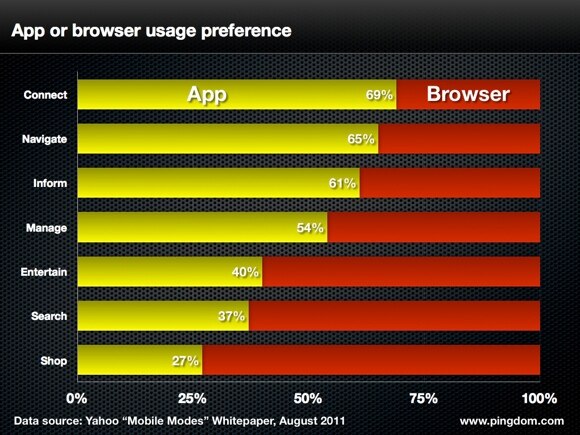
Other numbers:
- 48% – Percentage of U.S. smartphone users that favored browsers over apps.
- 2011 – In June, for the first time ever, daily time spent in mobile apps surpassed desktop and mobile web consumption.
- 58% – The share of mobile Internet users in the U.S. that get their content through a browser.
- 56 minutes – The time the average Android consumer in the U.S. spends per day actively interacting with the web and apps on their mobile device.
- 2/3 – The portion of that time that is spent on mobile apps, the remaining one-third is spent on the mobile web.
Social networking
Almost parallel to the explosion in mobile web over recent years we see a similar development in social networking, with services like Twitter and Facebook leading the way. Combine mobile web and social networking, add in location-aware services, and you have an incredibly popular set of tools that users around the world have taken to and use in their personal as well as professional lives. We start with an interesting tidbit about social networking and mobile users – more than 50% of mobile users in the U.S. that access social networking services do it through the mobile web on their device:
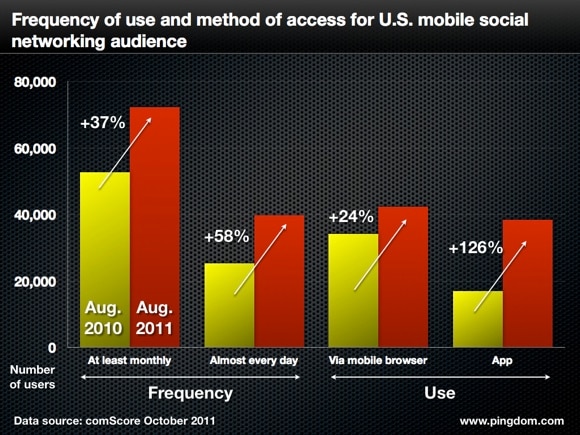
Some other information we found relating to mobile social networking:
- 19% – Share of posts on Facebook done via mobile web (m.facebook.com).
- 350 million – The number of Facebook users that log in to the service using their mobile phone.
- 35 – 54 – The most active age group in accessing social networks with mobile.
- 47% – Share of Europeans with smartphones that browse the mobile Internet every day.
- 66% – Share of Europeans with smartphones that connect to social media services every day with their mobile device.
- 30% – Percentage of smartphone owners that have accessed social networks via browser.
- >50% – Percentage of mobile page views accounted for by social networking sites.
Mobile commerce
NFC and mobile wallets dominated the mobile commerce headlines in 2011 but the mobile web is also seeing quite a bit of action when it comes to mobile commerce:
- 10.8% – Percentage of people surveyed by IBM that used a mobile device to visit a retailer’s site on Cyber Monday 2011.
- 3.9% – The corresponding percentage for Cyber Monday in 2010.
- 50% – The portion of visits to retail websites that came from the mobile web.
- 45% – The percentage of U.S mobile users that were expected to compare prices via their handsets during their Thanksgiving weekend shopping.
- 49% – This many consumers who use the mobile web at least once a week also made a purchase on their mobile device in the past six months.
Tablets
We finish off with a quick look at tablets and the mobile web. Tablets are generally used as media-consumption devices and they are used more for browsing the web than smartphones, as show by this chart:
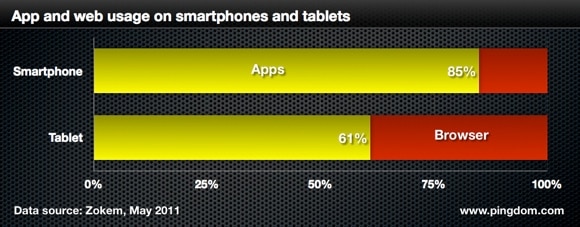
More tablet and mobile web related information:
- 10.3 million – Number of tablet users in 2010.
- 82.1 million – Number of tablet users expected in 2015.
- 21% – Tablet’s share of mobile traffic to retailer sites.
- 88% – Apple iPad’s share of global tablet web traffic.
The mobile web in 2012
We’re not going to predict any numbers for the mobile web in 2012 but it’s a safe bet that everything will be bigger, faster, and more of it.
What’s really amazing is that if the predictions are right, most websites will soon see more traffic from mobile devices than from computers. The effects that will have on not just the design and development of sites, but also on business opportunities, will be more profound than anything else we’ve experienced so far on the Internet.
We hope you found some useful information in our roundup of the mobile web in 2011. Now it’s up to you to apply this in your business.
Sources are linked to for each item in this article. We want to especially acknowledge MobiThinking’s “Global mobile statistics 2011” page for guiding us to many of the resources used. Numbers for best selling mobile devices come from Wikipedia.



























